
Ficus benjamina, commonly known as weeping fig, benjamin fig or ficus tree, and often sold in stores as just ficus, is a species of flowering plant in the family Moraceae, native to Asia and Australia. It is the official tree of Bangkok. The species is also naturalized in the West Indies and in the states of Florida and Arizona in the United States. In its native range, its small fruit are favored by some birds.

The water-plantains (Alismataceae) are a family of flowering plants, comprising 20 genera and 119 species. The family has a cosmopolitan distribution, with the greatest number of species in temperate regions of the Northern Hemisphere. Most of the species are herbaceous aquatic plants growing in marshes and ponds.

Echinodorus, commonly known as burhead or Amazon sword, is a genus of plants in the family Alismataceae, native to the Western Hemisphere from the central United States to Argentina. Its scientific name is derived from Ancient Greek echius – "rough husk" - and doros – "leathern bottle" - alluding to ovaries, which in some species are armed with persistent styles, forming prickly head of fruit. Some of the species are commonly cultivated in artificial aquatic habitats.

Echinodorus cordifolius, the spade-leaf sword or creeping burhead, is a species of aquatic plants in the Alismatales. It is native to Mexico, the West Indies, Central America, South America and the southeastern United States.
Echinodorus tunicatus is a species of aquatic plants in the family Alismataceae.

Echinodorus longiscapus is a perennial, aquatic plant of the Alismataceae, native to South America. It is cultivated as a pond or aquarium plant.

Echinodorus macrophyllus is a species of aquatic plants in the Alismataceae. It is native to Brazil and Bolivia.
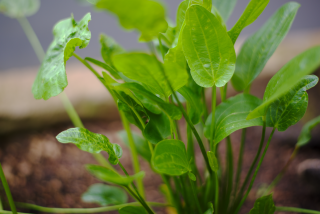
In Rataj's taxonomy Echinodorus ovalis is in Section Cordifolii, Subgenus Echinodorus. It is related to Echinodorus cordifolius and listed by some authorities and importers as a synonym of that species, e.g. E. cordifolius 'ovalis'.
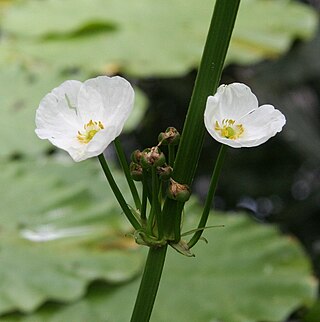
Echinodorus subalatus is a species of aquatic plants in the Alismataceae. It is native to Cuba, Mexico, Central America, Guyana, Venezuela, Bolivia, Brazil and Paraguay. It is found naturally growing in mud by the side of streams.
Echinodorus trialatus is a type of plant. In Rataj's taxonomy, E. trialatus is in Section Paniculati, Subgenus Echinodorus.

Echinodorus uruguayensis or Echinodorus osiris is a plant species in the Alismataceae. It is native to South America.

Echinodorus berteroi is an aquatic plant species in the Alismataceae It is native to the southern and central parts of the United States, as well as Central America, the West Indies, and South America as far south as Argentina.
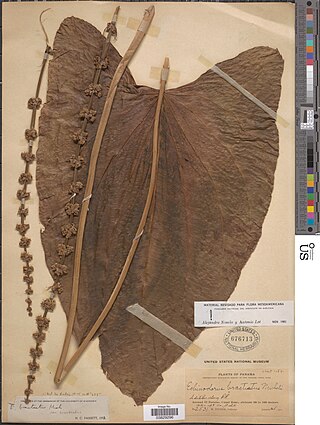
Echinodorus bracteatus is a species of plants in the Alismataceae. It is native to Costa Rica, Nicaragua, Panama, Colombia and Ecuador.
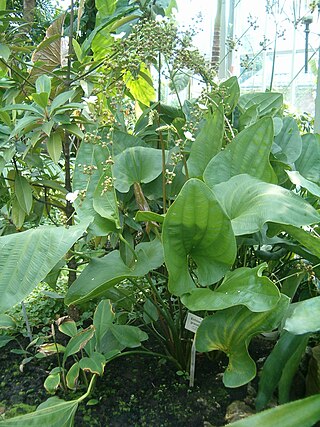
Echinodorus grandiflorus is a plant species in the Alismataceae. It is native to Brazil, Paraguay, Uruguay, Argentina, Venezuela and Florida.

Dudleya lanceolata is a succulent plant known by the common name lanceleaf liveforever or lance-leaved dudleya. It is an extremely variable and widely ranging species that occurs from Monterey County and Kern County in California south through Ensenada in Baja California. It is characterized by green to purple lanceolate leaves, red, orange, or less commonly yellow petals, and is typically tetraploid. Despite its diversity, it is quite stable as a species, but hybrids may be discovered with other species of Dudleya, which can make it difficult to discern in areas where numerous species converge.
Albidella is a genus of plants in the Alismataceae. At the present time, four species is known. In 2014(when this page is first made),One is Albidella nymphaeifolia, formerly called Echinodorus nymphaeifolius. It is native to Cuba and the Yucatán Peninsula.
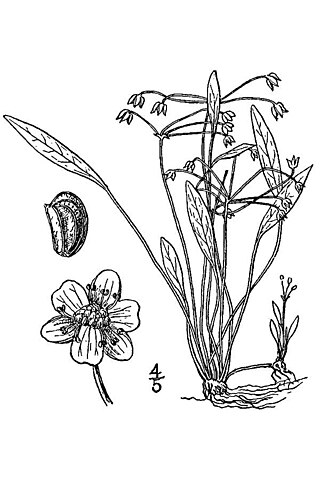
Helanthium tenellum, the pygmy chain sword, is a species of plants in the Alismataceae. It is native to the eastern United States, southern Mexico, West Indies, Central America, South America
Spathiostemon moniliformis is a plant that can grow as a shrub or a tree in the Euphorbiaceae family, Acalypheae tribe. It is endemic to southern/peninsular Thailand.
Zanthoxylum echinocarpum is a woody plant in the family Rutaceae and is native to South-Central and Southeast China.

Scilla lilio-hyacinthus, the Pyrenean squill, is a species of flowering plant plant in the genus Scilla.















